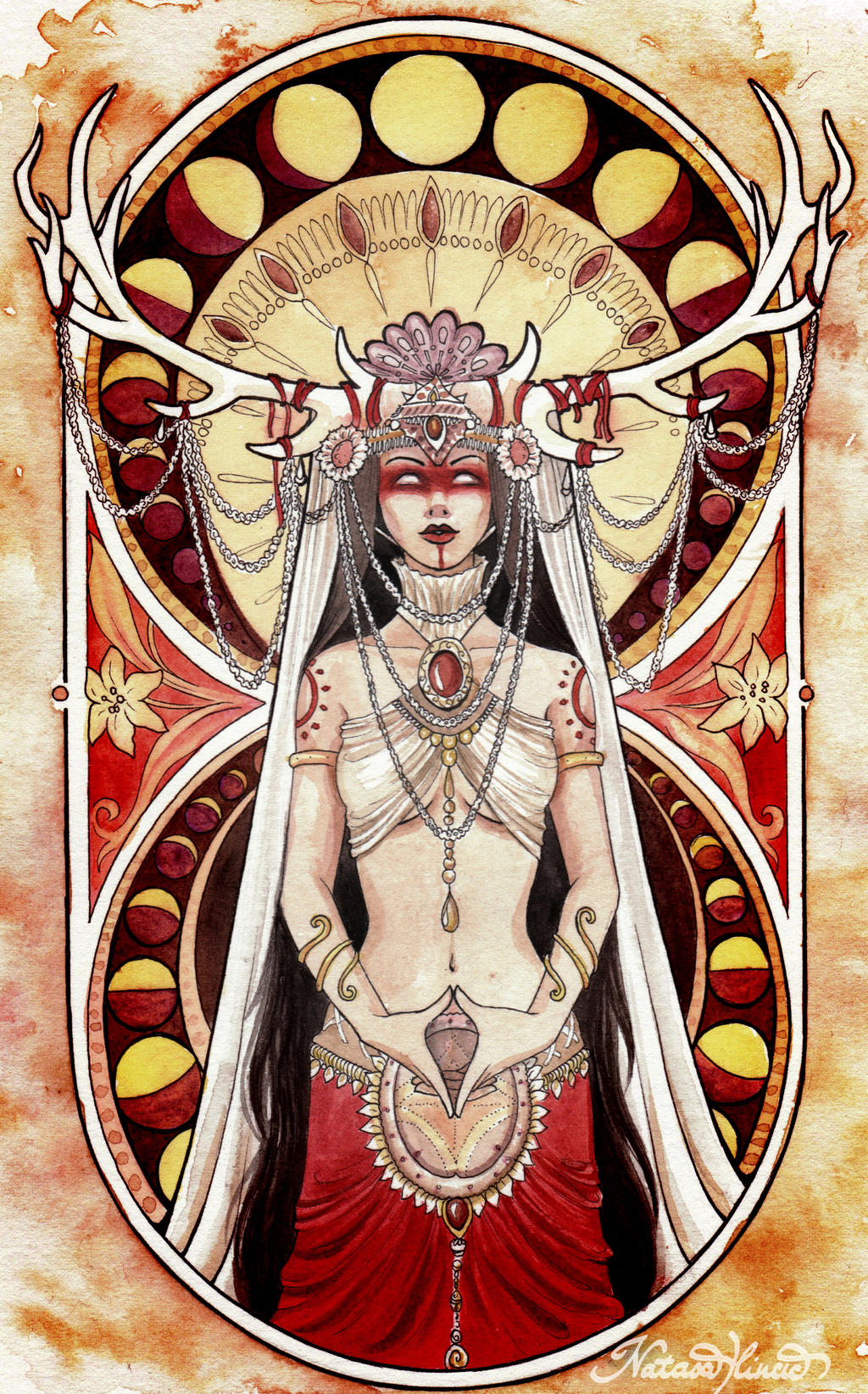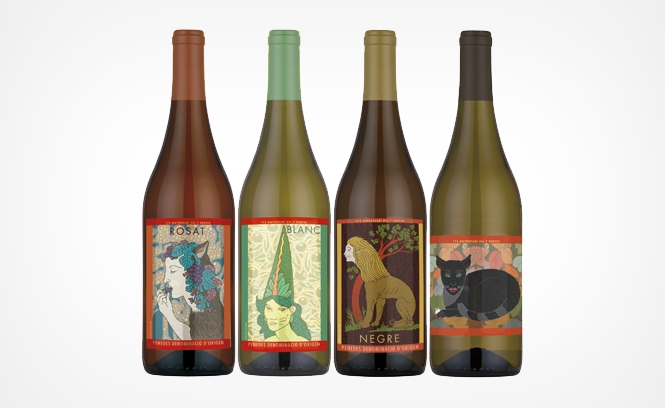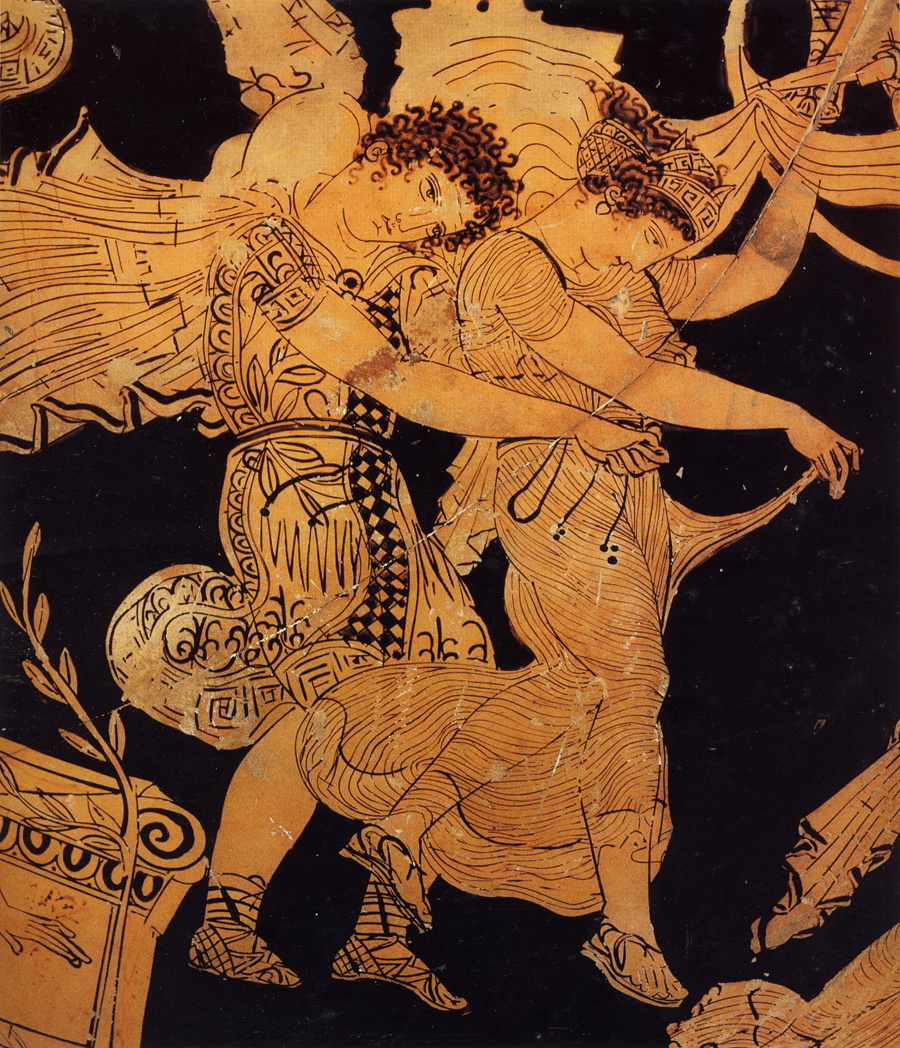There are also other artifacts, such as the Tartaria tablets (5500 bce), Hieroglyphics (2700 bce), and Ancient Greek pottery (600 - 450 bce), which help reflect the idea of art in the past, and show clear influence over many contemporary designers in today's society.
One specific artist who is particularly inspired by the likes of the Art Nouveau, Pre-Raphaelites, Neoclassical and Victorian artists is a Croatian artist by the name of Natasa Ilincic. Many of her pieces are depictions of old God's, and at times her style, composition and use of intricate pattern put me in mind of the Czech decorative artist Alphonse Mucha, for example:
This particular piece follows the same distinct classical composition that Mucha usually displays in his own pieces, showing a decorative, patterned background and a figure protruding out of the design work as the main focus. Her intricate use of line work is also similar to Mucha's in the sense that the outline is much bolder than any line work used to add detail, creating an odd sense of perspective within the flat image. Clearly, past influence has played a large role in the creation of this more modern piece.
Another artist which appears to be influenced by the Art Nouveau movement/Alphonse Mucha is New York illustrator Les Katz with her Marilyn Monroe painting:
Although this piece appears more typically like a fine-art painting over Mucha's borderline fine-art/graphic design displays, it's evident there has been some influence from his work involved. For example, the composition involves the typical feminine figure placed in front of an intricate, circular design. Despite the medium appearing to differ from Mucha's, the use of colours also appear similar in the sense that they're very soft and blend easily with one another, creating a seamless transition between the highlights and shadows of the piece. As a whole I really like how this piece shows clear influence from Mucha's art style - yet it still differs in its own respect and remains a piece in itself without being a complete mimic of another artist's style (something I find very admirable as it's very easy to just 'copy' a style).
Milton Glaser is a graphics designer highly regarded in the United States, and whilst browsing through his work done for clients and taking in his array of styles, I noticed one piece of work in particular:
and compare it to Milton's wine labels, it becomes evident that there are notable similarities between the two. The first thing I noticed about Milton's designs was the style of the heads. especially the side profile depicted on the first wine bottle. There are striking similarities between that and the one displayed on the vase (right down to the shape of the nose), showing unmistakable signs of past influences over contemporary design. Even things such as the subdued, earthy tones and the type of lines used reflect artwork from past Grecian/Egyptian times.
Pablo Picasso was also an artist who was heavily influenced by past artifacts, especially African styled masks.
As you can see by the image above there are several obvious similarities which tie both pieces together. Picasso's Head of a Woman (1907) shows clear use of the exaggerated features depicted in the dan mask, creating a rather grotesque, abstract image. There is also use of earthy tones, reflecting the original browns in the mask, and even the textures appear similar. If you look at the shape of the woman's head in Picasso's piece it also becomes apparent that it's the exact same shape as the mask, only inverted.
So it becomes clear that past influences are inevitable, they're perceptible in all kinds of work and we, as contemporary artists and designers, are continuously drawing inspiration from a wide variety of things we've previously seen, whether it's a subconscious act or a conscious one.
Sources used:
One specific artist who is particularly inspired by the likes of the Art Nouveau, Pre-Raphaelites, Neoclassical and Victorian artists is a Croatian artist by the name of Natasa Ilincic. Many of her pieces are depictions of old God's, and at times her style, composition and use of intricate pattern put me in mind of the Czech decorative artist Alphonse Mucha, for example:
Another artist which appears to be influenced by the Art Nouveau movement/Alphonse Mucha is New York illustrator Les Katz with her Marilyn Monroe painting:
Although this piece appears more typically like a fine-art painting over Mucha's borderline fine-art/graphic design displays, it's evident there has been some influence from his work involved. For example, the composition involves the typical feminine figure placed in front of an intricate, circular design. Despite the medium appearing to differ from Mucha's, the use of colours also appear similar in the sense that they're very soft and blend easily with one another, creating a seamless transition between the highlights and shadows of the piece. As a whole I really like how this piece shows clear influence from Mucha's art style - yet it still differs in its own respect and remains a piece in itself without being a complete mimic of another artist's style (something I find very admirable as it's very easy to just 'copy' a style).
Milton Glaser is a graphics designer highly regarded in the United States, and whilst browsing through his work done for clients and taking in his array of styles, I noticed one piece of work in particular:
The designs of the labels caught my attention as they reminded me specifically of artwork seen on Grecian pottery and in Ancient Egyptian times. If we look at this image taken from a Grecian vase:
Pablo Picasso was also an artist who was heavily influenced by past artifacts, especially African styled masks.
As you can see by the image above there are several obvious similarities which tie both pieces together. Picasso's Head of a Woman (1907) shows clear use of the exaggerated features depicted in the dan mask, creating a rather grotesque, abstract image. There is also use of earthy tones, reflecting the original browns in the mask, and even the textures appear similar. If you look at the shape of the woman's head in Picasso's piece it also becomes apparent that it's the exact same shape as the mask, only inverted.
So it becomes clear that past influences are inevitable, they're perceptible in all kinds of work and we, as contemporary artists and designers, are continuously drawing inspiration from a wide variety of things we've previously seen, whether it's a subconscious act or a conscious one.
Sources used:





No comments:
Post a Comment